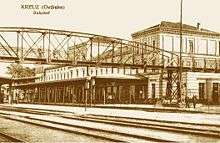Krzyż Wielkopolski
| Krzyż Wielkopolski | ||
|---|---|---|
|
The post office from early of the XX century.
| ||
| ||
 Krzyż Wielkopolski | ||
| Coordinates: 52°52′45″N 16°0′30″E / 52.87917°N 16.00833°E | ||
| Country |
| |
| Voivodeship | Greater Poland | |
| County | Czarnków-Trzcianka | |
| Gmina | Krzyż Wielkopolski | |
| Established | 18th century | |
| Town rights | 1936 | |
| Government | ||
| • Mayor | Jolanta Korbik | |
| Area | ||
| • Total | 5.83 km2 (2.25 sq mi) | |
| Population (2006) | ||
| • Total | 6,283 | |
| • Density | 1,100/km2 (2,800/sq mi) | |
| Time zone | CET (UTC+1) | |
| • Summer (DST) | CEST (UTC+2) | |
| Postal code | 64-761 | |
| Area code(s) | +48 67 | |
| Car plates | PCT | |
| Website | http://www.krzyz.pl | |
Krzyż Wielkopolski [ˈkʂɨʂ vʲɛlkɔˈpɔlskʲi] (German: Kreuz (Ostbahn)) is a town in Poland, with 6,317 inhabitants (2004) in Czarnków-Trzcianka County, Greater Poland Voivodship. It is an important railroad junction, with two major lines crossing there - the Berlin - Bydgoszcz and Poznań - Szczecin connections. The town owes its existence to the rail, as developed only after 1848, when the Poznań - Szczecin line was opened, crossing the Prussian Eastern Railway. In fact its name (Krzyz and Kreuz in English mean cross) reflects the fact that rail lines cross there. Krzyz was area of heavy Polish-German fighting in 1919, during the Greater Poland Uprising (1918–1919) and it remained part of Germany in the interbellum period, located only 2 kilometers from then-borderline. It was incorporated as a town in 1936 and after World War II it became part of Poland.

Coordinates: 52°52′45″N 16°00′30″E / 52.87917°N 16.00833°E

